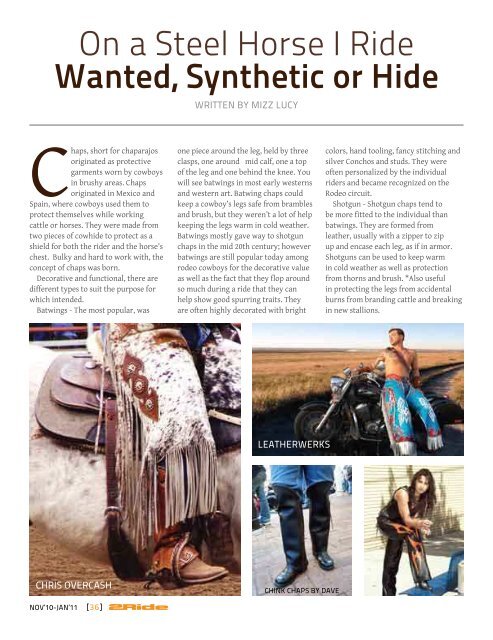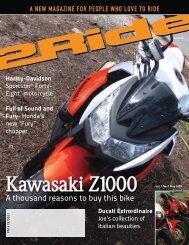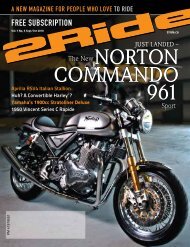Free SubScriPtioN - 2Ride Motorcycle Magazine
Free SubScriPtioN - 2Ride Motorcycle Magazine
Free SubScriPtioN - 2Ride Motorcycle Magazine
You also want an ePaper? Increase the reach of your titles
YUMPU automatically turns print PDFs into web optimized ePapers that Google loves.
On a Steel Horse I ride<br />
Wanted, Synthetic or Hide<br />
Chaps, short for chaparajos<br />
originated as protective<br />
garments worn by cowboys<br />
in brushy areas. Chaps<br />
originated in Mexico and<br />
Spain, where cowboys used them to<br />
protect themselves while working<br />
cattle or horses. They were made from<br />
two pieces of cowhide to protect as a<br />
shield for both the rider and the horse’s<br />
chest. Bulky and hard to work with, the<br />
concept of chaps was born.<br />
Decorative and functional, there are<br />
different types to suit the purpose for<br />
which intended.<br />
Batwings - The most popular, was<br />
CHRIS oveRCaSH<br />
WRITTen BY MIzz LuCY<br />
one piece around the leg, held by three<br />
clasps, one around mid calf, one a top<br />
of the leg and one behind the knee. You<br />
will see batwings in most early westerns<br />
and western art. Batwing chaps could<br />
keep a cowboy’s legs safe from brambles<br />
and brush, but they weren’t a lot of help<br />
keeping the legs warm in cold weather.<br />
Batwings mostly gave way to shotgun<br />
chaps in the mid 20th century; however<br />
batwings are still popular today among<br />
rodeo cowboys for the decorative value<br />
as well as the fact that they flop around<br />
so much during a ride that they can<br />
help show good spurring traits. They<br />
are often highly decorated with bright<br />
LeaTHeRWeRkS<br />
CHInk CHaPS BY Dave<br />
colors, hand tooling, fancy stitching and<br />
silver Conchos and studs. They were<br />
often personalized by the individual<br />
riders and became recognized on the<br />
Rodeo circuit.<br />
Shotgun - Shotgun chaps tend to<br />
be more fitted to the individual than<br />
batwings. They are formed from<br />
leather, usually with a zipper to zip<br />
up and encase each leg, as if in armor.<br />
Shotguns can be used to keep warm<br />
in cold weather as well as protection<br />
from thorns and brush. *Also useful<br />
in protecting the legs from accidental<br />
burns from branding cattle and breaking<br />
in new stallions.<br />
Chinks (short for chinkaderos) -<br />
Chinks came along in the latter part<br />
of the 20th century and have grown<br />
quite popular,Chinks have been called<br />
“cowboy shorts” by some individuals<br />
who don’t want to change, but they are<br />
quite practical for the working cowboy.<br />
Usually made in a similar fashion<br />
to shotguns, chinks are simply cut off<br />
around knee to mid-calf level, and have<br />
fringe around the outer edge. Much<br />
more comfortable in warm weather,<br />
chinks, like batwings and shotguns,<br />
serve a purpose in the cowboy life<br />
style. Since most cowboys wear<br />
boots that come up near the knee,<br />
chinks protect the area above<br />
the boot.<br />
Woollies or Angoras - were<br />
introduced in the late 1800’s.<br />
Basically, any animal skin with<br />
hair would be suitable; such as<br />
lion, bear, buffalo, angora goats,<br />
leopard, dogs and even seal. The<br />
warmth and water repellant<br />
qualities of these skins made life<br />
much more bearable in the colder<br />
northern climates, by working<br />
cowboys when full length leather<br />
chaps would prove to be too<br />
restrictive or simply too hot in<br />
warmer southern climates.<br />
Leather Chaps - have been<br />
a part of livestock handling life for<br />
centuries in one form or another.<br />
The Mexican Vaqueros created<br />
leather britches called Armitas<br />
in the early 1800’s. Made from<br />
various animal skins, the legs of<br />
the Armitas were attached to a<br />
belt worn at the waist and were<br />
secured to the legs. From about<br />
1870 to the 1900’s, the Armitas<br />
were mostly used during ground<br />
work such as yard work, fencing,<br />
branding, feeding etc. They were<br />
a ‘step into’ garment with no ties or<br />
buckles around the legs, and secured to<br />
a full belt.<br />
In the 1940’s Leather chaps where<br />
also worn by men in the military when<br />
riding their motorcycles in combat,<br />
again to protect their legs from the<br />
heat of the engine and debris from the<br />
fight. Some motorcyclists refer to their<br />
bikes as Iron Steeds or Iron Horses and<br />
often live life with the same free spirit<br />
that the old cow folk did. It comes as no<br />
surprise that bikers would adopt chaps<br />
as a functional protective garment for<br />
braving the elements, especially the fall<br />
from uncontrolled situations.<br />
Cowhide typically the best material<br />
to construct chaps from has excellent<br />
strength and durability. ‘Top’ grain<br />
leather, which has been sanded and<br />
lacquered to remove any imperfections,<br />
can be 1.3mm thick and provide<br />
protection. But, the best protection<br />
against the elements and road rash<br />
is ‘Naked’ cowhide. Treated by just<br />
removing the hair and applying dyes,<br />
this process allows the final product to<br />
be at least 2mm thick.<br />
So, how do we come about a pair<br />
that fits and does what it is intended<br />
to do? By customization to your body’s<br />
shape by professionals that have taken<br />
a liking in producing quality chaps that<br />
are highly functional to the individual.<br />
I personally love the look and feel of<br />
leather and have mine made by Terez<br />
Leather, as she knows what will or will<br />
not look good on an individual just by<br />
how the material hangs off one’s torso.<br />
That’s why the importance of the quality<br />
and type of hide will suit the<br />
style that one would want in<br />
a chap.<br />
Let’s not forget the various<br />
synthetic materials so commonly<br />
used today. The first pair was<br />
made for a Wyoming cowboy<br />
who hunted elk in Levis® no<br />
matter how extreme the fall<br />
Rocky Mountain weather got.<br />
Any outdoors man or woman<br />
can’t say enough about how<br />
cold and dangerous wet cotton<br />
can be. So instead of bulky snow<br />
pants, a modern version of chaps,<br />
that replaced heavy leather was<br />
a lightweight mobile waterresistant<br />
nylon used to make<br />
backpacks. That was many years<br />
ago and since then the word has<br />
gotten out. The largest following<br />
comes from motorcyclists who<br />
want something lighter, more<br />
comfortable and packable than<br />
the common leather chaps. Many<br />
special options like reflective<br />
tape, heat resistant Kevlar, mesh<br />
back for hot weather, CE certified<br />
knee armor, and for the total<br />
diehards, fleece lining. It turns<br />
out that equestrians like<br />
them too!<br />
They also have matching<br />
jackets, gloves and helmets to complete<br />
the look, and make you an individual.<br />
No matter what your style of bike,<br />
no matter what your style of chaps,<br />
it is important to protect yourself<br />
against the elements and what life has<br />
to throw at us.<br />
nov’10-jan‘11 [36] nov’10-jan‘11 [37]





